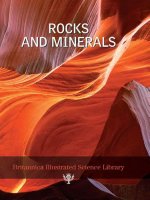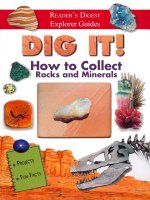Unit 4 notes rocks and minerals
Bạn đang xem bản rút gọn của tài liệu. Xem và tải ngay bản đầy đủ của tài liệu tại đây (194.41 KB, 25 trang )
Unit 4 – Rocks
and Minerals
Essential Questions
•What is a mineral?
•How do we identify minerals?
•What can minerals be used for?
•What is a rock?
•How are the different types of rock
formed?
Unit 4 – Rocks
and Minerals
Lesson 1 – Minerals:
Vocabulary
•mineral
•crystal
Unit 4 – Rocks
and Minerals
Lesson 1 – Minerals
•A mineral is a naturally occurring,
inorganic solid with a definite
composition, and an orderly arrangement
of atoms.
•All minerals form crystals, a definite
shape that comes from repeated
patterns. They’re six known patterns for
all minerals.
Unit 4 – Rocks
and Minerals
Lesson 1 – Minerals (cont.)
•Crystals form in several ways.
•One way is when hot melted rock, called
magma, cools.
•When magma cool slowly, the
crystalline structure formed is large
enough to see.
•When magma cools rapidly, the
crystalline structure formed is not always
large enough to see.
Unit 4 – Rocks
and Minerals
Lesson 1 – Minerals (cont.)
•98 elements occur naturally in Earth’s crust,
but only 8 of them make up the majority of it
(by weight).
•Oxygen (O) and silicon (Si) are the two most
abundant elements in Earth’s crust. Thus,
they are the building blocks for most minerals.
•Silicates are minerals that contain silicon (Si)
and oxygen (O) and usually one or more
elements.
Unit 4 – Rocks
and Minerals
Lesson 2 – Mineral
Identification: Vocabulary
•hardness
•luster
•streak
Unit 4 – Rocks
and Minerals
Lesson 2 – Mineral Identification
The Seven Physical Properties of Minerals:
1. Appearance: How it looks.
2. Color: What color it appears to be.
3. Luster: How light reflects from its
surface. Metallic – shiny or nonmetallic
– dull, pearly, silky, and glassy.
Unit 4 – Rocks
and Minerals
Lesson 2 – Mineral
Identification (cont.)
4. Streak: The color of the mineral when it
is powdered. This test works only for
minerals that are softer than the streak
plate.
5. Cleavage/ Fracture: Minerals that break
along smooth, flat surfaces have
cleavage. Minerals that break with
uneven or jagged surfaces have fracture.
Unit 4 – Rocks
and Minerals
Lesson 2 – Mineral
Identification (cont.)
6. Hardness: A measure of how easily a
mineral can be scratched. The Mohs
Hardness Scale is used to compare an
unknown mineral to several known ones.
The harder mineral always scratches
the softer one.
7. Other Properties: Some minerals have
unique properties; like magnetism,
bending light, or fizzing in the presence of
Unit 4 – Rocks
and Minerals
Lesson 2 – Mineral Identification:
Mineral ID Lab – Day 1
•Step 1) Question: Can I identify the unknown
minerals?
•Step 2) Research: Use the materials
provided by the teacher.
•Step 3) Hypothesis:
•Step 4) Procedures:
Unit 4 – Rocks
and Minerals
Lesson 2 – Mineral Identification:
Mineral ID Lab – Day 2 (cont.)
•Step 5) Perform:
•Step 6) Data Table: (Day 1)
•Step 7) Interpret Data:
•Step 8) Conclusion:
– Which properties were most and least useful
for identifying your minerals? Why? [BE
SPECIFIC]
– Refer to your hypothesis.
Unit 4 – Rocks
and Minerals
Lesson 3 – Mineral Uses:
Vocabulary
•gem
•ore
Unit 4 – Rocks
and Minerals
Lesson 3 – Mineral Uses
•Gems or gemstones are highly prized minerals
because they are rare and beautiful.
•A mineral is an ore if it contains a useful
substance that can be mined at a profit.
•Under certain conditions, metallic elements can
dissolve in fluids. These fluids then travel through
weaknesses in rocks and form ore deposits or
vein minerals.
Unit 4 – Rocks
and Minerals
Lesson 4 – Rock Cycle:
Vocabulary
•rock
•rock cycle
Unit 4 – Rocks
and Minerals
Lesson 4 – Rock Cycle
•A rock is a mixture of minerals, mineraloids,
glass, or organic matter.
•Rocks are constantly changing from one
type to another. Scientists have created a
model called the rock cycle, to illustrate the
process.
Unit 4 – Rocks
and Minerals
Lesson 5 – Igneous, Metamorphic,
and Sedimentary Rock: Vocabulary
•igneous rock
•intrusive
extrusive
•sedimentary rock
•sediment
•metamorphic rock
Unit 4 – Rocks
and Minerals
Lesson 5 – Igneous, Metamorphic,
and Sedimentary Rock
•When the molten material, called magma,
from a volcano or from deep inside the Earth
cools, it forms igneous rock.
•When igneous rock forms beneath the
Earth’s surface it’s called intrusive igneous
rock. This rock cools very slowly; so there is
time for large crystals to form, called coursegrained rock (ex. Granite).
Unit 4 – Rocks
and Minerals
Lesson 5 – Igneous, Metamorphic,
and Sedimentary Rock (cont.)
•When a volcano erupts, magma comes up
to the surface as lava and cools rapidly.
•This kind of igneous rock is called extrusive
igneous rock. Generally, these rocks have
small or no crystals, called fine-grained rock
(ex. Pumice, Obsidian).
Unit 4 – Rocks
and Minerals
Lesson 5 – Igneous, Metamorphic,
and Sedimentary Rock (cont.)
•Sedimentary rocks form when sediments
become pressed or cemented together, or
when minerals come out of mineral-rich
solution, or are left behind by evaporation.
•Sediments are loose materials such as rock
fragments, mineral grains, and bits of plant
and animal remains that have been moved.
Unit 4 – Rocks
and Minerals
Lesson 5 – Igneous, Metamorphic, and
Sedimentary Rock (cont.)
•Weathering & erosion break down and move rock bits.
•If the sediments are small, with enough pressure, they
can stick together and form solid rock. This process is
called compaction.
•If the sediments are large, like sand and pebbles, then
they have to be cemented together. Cementation occurs
when water and dissolved minerals seep through the
open spaces and harden into a natural glue.
Unit 4 – Rocks
and Minerals
Lesson 5 – Igneous, Metamorphic,
and Sedimentary Rock (cont.)
•Chemical sedimentary rock forms when
dissolved minerals come out of a solution or
are left behind due to evaporation (ex.
Limestone, Rock Salt).
•Biochemical sedimentary rock forms from
the remains of once living things (ex. Fossilrich Limestone, Coal).
Unit 4 – Rocks
and Minerals
Lesson 5 – Igneous, Metamorphic,
and Sedimentary Rock (cont.)
•Rocks that change because of temperature,
pressure, or presence of hot, watery fluids
are metamorphic rocks.
•Metamorphic rocks form from other rocks.
•Heat & pressure change the igneous rock
granite into gneiss (a metamorphic rock).
Unit 4 – Rocks
and Minerals
Lesson 5 – Igneous, Metamorphic, and
Sedimentary Rock (cont.)
•This metamorphic rock has bands of minerals, or
parallel layers, called a foliated texture.
•Heat & pressure change the sedimentary rock
sandstone into quartzite (a metamorphic rock).
Another example is limestone to marble.
•These metamorphic rocks have no bands of
minerals, or parallel layers, called a non-foliated
texture.
Unit 4 – Rocks
and Minerals
Lesson 5 – Igneous,
Metamorphic, and Sedimentary Rock :
Rock ID Lab – Day 1
•Step 1) Question: Can I identify the unknown
rocks?
•Step 2) Research: Use the materials
provided by the teacher.
•Step 3) Hypothesis:
•Step 4) Procedures:
Unit 4 – Rocks
and Minerals
Lesson 5 – Igneous,
Metamorphic, and Sedimentary Rock :
Rock ID Lab – Day 2 (cont.)
•Step 5) Perform:
•Step 6) Data Table: (Day 1)
•Step 7) Interpret Data:
•Step 8) Conclusion:
– Which properties were most and least useful
for ID’ing your rocks? Why? [BE SPECIFIC]
– Refer to your hypothesis.









